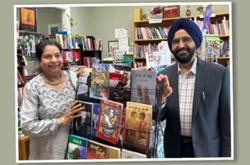
What do you find more engaging: reading an article in a newspaper, or having a conversation about it with a friend afterwards? This is the question journalists, editors, and media executives should be asking themselves as they try to navigate through the current crisis in journalism. If you're like me, you find the conversation about current events more interesting than the consumption of news.
It appears that the Internet is facilitating an increase in expression, collaboration and conversation. The pattern is dispersed and uneven, but unmistakable. The current crisis in big business-supported journalism, coupled with the explosion of personal expression through online media, is fundamentally transforming journalism practices and giving way to the emergence of a more participatory form of journalism.
This is not just about new technologies or online tools, but rather new forms of journalism (and other practices) that are enabled by new online tools.
Social media is not journalism's competition
Social media and "professional" journalism are not mutually exclusive. I've previously detailed how the crisis in journalism is largly the result of big media itself and bad public policy. Comparing professional journalism and social media is like comparing the phone to broadcast news. Sure the phone hasn't enabled mass distribution of content the way the Internet has, but like social media, it is conversation based, participatory, and dynamic. Like the phone, social media should be considered a tool that professional journalists use, rather than their competition. This is exactly the approach the HuffingtonPost took when they developed their new Social News project, which encourages audience conversation through integration with Facebook.
Online tools enable mass distributed labour, which can be very useful for journalism. Rather than calling up one source, you can have your 'audience' or 'participants' help you do the research and fact checking. 'Crowd sourcing' can widen the scope and depth of newsgathering and can broaden engagement with media participants. Crowd sourcing allows user-produced Wikipedia to out-compete 'professional' encyclopedias and open source software projects like FireFox to compete with corporate giants like Microsoft. If these domains can be reinvented, perhaps journalism is next.
A New Relationship between journalists and audiences
NYU Journalism professor Jay Rosen calls this new form of journalism "Pro-Am", short for professional and amateur. According to Rosen, "the pro-am approach looks for the hybrid forms that combine substantial openness with some controls." Those controls come in the form of journalists acting as facilitators of collaborative crowd sourced journalism. Rosen maintains that Pro-Am or participatory journalism "won't replace what traditional newsrooms do, but if taken seriously and used properly, this pro-am model has the potential to radically extend the reach and effectiveness of professional journalism."
The Guardian Newspaper harnessed their online community towards producing better professional journalism by inviting people to read through MP expense documents, normally considered a highly expensive initiative. To date, 23,376 people have reviewed 204,477 pages for the Guardian.
Ingredients for participatory journalism
A Canadian example of this transformation in journalism practices can be found in perhaps the most unlikely of places: the Financial Post. The FP's live blog coverage of the CRTC's traffic management hearing, facilitated by journalist Matt Hartley, was engaging, interactive and timely. Hartley, both a skilled online discussion facilitator and someone knowledgeable about the media and telecommunications industry, added value to the discussion by inviting people who presented at the hearing to join in the discussion. Hartley kept the discussion open -- all twitter chats that were appropriately tagged and automatically fed into the conversation and on-topic messages were moderated and posted quickly. This openness made the content flexible to user habits and preferred levels of engagement.
The FP's coverage was successful as a result of the following three basic ingredients necessary for engaging participatory journalism:
1. Good Facilitation (skilled, respected, knowledgeable) 2. Value (informative/relevant content) 3. Openness (provides access via various points of entry)
Keep it simple
Participatory journalism need not be complicated; sometimes it's just a matter of incorporating the conversation that is already happening online. For example, when I was asked to go on the Dave Brindle show to talk about the use of Twitter in the uprising in Iran, I sent a message to my Facebook and Twitter networks asking for input. The input I received helped inform my comments on the show -- but more importantly, David Brindle took note of the discussion and used the comments as conversation points during the interview. Thus we had radio journalism that was crowd-sourced and integrated into a broader discussion that was happening online.
Another example of creating new media by tapping into existing discussions can be found on two new websites: PoliTwitter and TweetCommons. These sites connect Canadians with their elected representatives in government by drawing in Twitter feeds and therefore online conversations.
Ownership matters
Waiting for big corporations to become purveyors of open, transparent and participatory journalism will be a long wait indeed. As Jay Rosen put it when talking about the current journalism system, "if you know how the old one fell apart, it's easier to put something new together." Keeping in mind that the greed of big media is largely responsible for the crisis in journalism, we can focus squarely on new independent and public projects.
Here in Canada, TVO, Rabble, The Tyee and others have made some bold steps in the world of participatory journalism. The Tyee has launched several crowd-sourced initiatives including its B.C. photo pool. Using Flickr, The Tyee posts a selection of pictures taken and uploaded by B.C. residents, which has nearly 2,500 photos in the pool to date. The Tyee also helped create the 'Green Your Campbell Cash' website that, after B.C.'s carbon tax rebate was announced, allowed people to post their ideas and initiatives for tackling climate change through collective spending and action. And The Tyee runs an occasional "Post-It" series that had them attend public events in Vancouver and ask residents to write on post-it notes how public transit can be improved. They took pictures of the answers, posted them online and used the citizen input for their article on the subject.
Rabble.ca's most recent participatory journalism initiative is its "You Ask" program. You Ask invites participants to drive video interviews of newsmakers and social movement leaders through posing questions via online video prior to interviews or in real time through an online chat feature.
TVO's The Agenda: on the Road recently ran a series of discussion panels hosted in local communities and focused on local issues. The show went one step further by allowing participants or 'the audience' to drive the direction of the discussions. Through an 'unconference' and social media tools, the show collected and acted on citizen input. According to Mark Kuznicki, a social media and community management consultant involved in the series, "TVO is mixing the best of old and new media to stimulate a higher level of citizen engagement."
Who will lead?
If properly resourced, the more democratically accountable, public and independent media outlets will be the new incubators of innovative forms of journalism. This is why it is still essential to re-imagine how journalism can be financially supported.
The public wants more participatory forms of media and we can't trust that large corporations, with their matrix of commercial and ideological interests, will be the curators of democratic dialogue. While some enlightened media outlets have taken up the challenge of reinventing journalism, apart from the prematurely cancelled ZED series and Exposure, the CBC and many other socially mandated media outlets have yet to take full advantage of online media tools.
Instead of considering media as static, it's time to consider it as part of an ongoing conversation. The media outlets that most effectively facilitate discussion and free expression with a mix of open citizen engagement and professional journalism will capture audiences. At first glance, social media tools and the web in general, appear to facilitate this best, but local outlets and news-based platforms also have a place in this new media ecology. The media terrain is in the process of being re-negotiated and public service media organizations should be at the forefront. ![]()
Read more: Media, Science + Tech















Tyee Commenting Guidelines
Comments that violate guidelines risk being deleted, and violations may result in a temporary or permanent user ban. Maintain the spirit of good conversation to stay in the discussion.
*Please note The Tyee is not a forum for spreading misinformation about COVID-19, denying its existence or minimizing its risk to public health.
Do:
Do not: